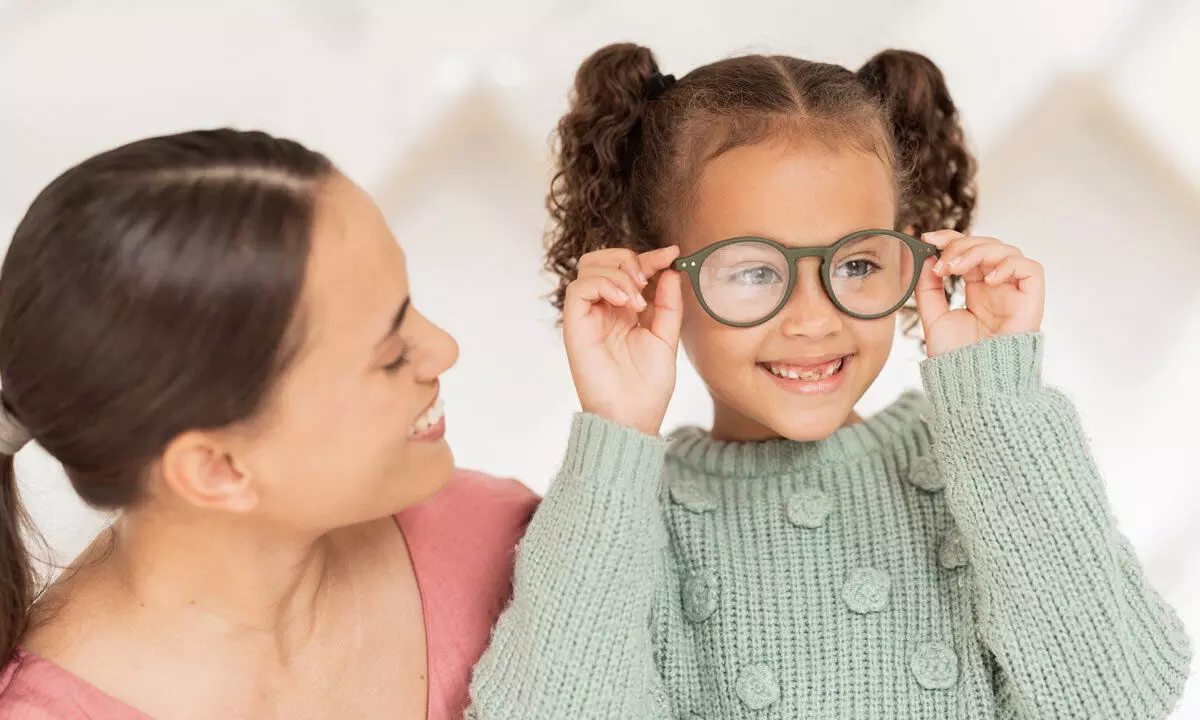Live
- Sandeep Reddy Vanga responds to 'female Arjun Reddy' question, teases woman-centric film
- Andhra Pradesh Government Simplifies Paddy Procurement with WhatsApp Services
- BJP to Hold Workshop, Plans Statewide Yatras and Rallies
- Yemen's Houthis claim hitting 'vital target' in Israel with drones
- Group-III examination centers were inspected at the field level by District Collector Adarsh Surabhi, SP Raula Giridhar IPS Wanaparthy
- Minister Nara Lokesh Pays Emotional Tribute to Late Nara Rammurthy Naidu
- Bihar: Deceased patient's eye missing, RJD condemns incident at Nalanda Medical College
- Rammurthy Naidu's Last Rites Held in Naravari Palli
- PM Modi receives ceremonial welcome in Abuja, begins bilateral talks with Nigerian President Tinubu
- Goods traffic doubles on the new railway freight corridors
Just In
Things parents should know about Myopia


Myopia, or nearsightedness, is rapidly becoming a global health concern, especially among young people.
Myopia, or nearsightedness, is rapidly becoming a global health concern, especially among young people. In urban areas of Asia, nearly 90% of individuals under the age of 20 are already myopic - a staggering statistic that highlights the growing prevalence of this condition. This is not just a regional issue - by 2050, it’s projected that 50% of the world’s population could be affected by myopia. The rise in screen time, reduced outdoor activities, and changing lifestyles are significant contributors to this alarming trend. If left unchecked, myopia can lead to severe vision problems, including an increased risk of retinal detachment, glaucoma, and even blindness. Urgent action is needed to raise awareness and implement strategies, from early detection to proper eye care, to curb this impending global vision crisis.
What Causes Myopia?
Genetics
Children who have one or both myopic parents are much more likely to become myopic themselves. Nearsightedness in children is twice as common in those with one myopic parent and up to six times more common in those with two myopic parents. Because of this strong hereditary correlation, parents should take extra care to ensure their children’s eye health.
Visual Habits
The rise in myopia is partly caused by the modern lifestyle, especially the extensive use of digital gadgets. Long periods of time spent using phones, tablets, or reading books up close are examples of “near work” that strains young eyes and hastens the onset of myopia. Therefore, the answer to the question “Can screen time cause myopia?” appears to be yes more and more. Children are more at risk for visual impairments the younger and more frequently they participate in screen-based activities.
Environment
Exposure to natural light is a component that is frequently disregarded. According to studies, a lack of outside time may hasten the growth of myopia. Because many children today spend their lives indoors, they are not getting enough natural light, which is essential for preserving eye health.
Treatment and Management Options
While there is no cure for myopia, there are several treatments and Myopia specific lenses available to slow its progression. Because of Myopia’s multifactorial causes, there’s no one-and-only treatment for myopia. In fact, there are many treatment options in the market including optical, medical and behavioral treatments.
The choice of myopia treatments for children should be based on the age of onset, and axial length or refraction at a given age, along with knowledge of their individual rate of progression and overall risk profile. Comprehensive myopia treatments include a combination of lifestyle advice, a refractive correction method for full-time use, and myopia control methods to reduce or eliminate further progression.
Specialized Lenses: ZEISS MyoCare lenses are most effective lens aimed to slow myopia progression in children. MyoCare is backed by ZEISS innovation and more than a decade of experience in developing lenses to manage myopia progression. The lenses feature advanced technology that manages accommodative condition that occurs during near-vision tasks and contributes to myopia progression. The lenses offer clear vision across all distances while also helping to slow the development of myopia.
Retina Workplace: ZEISS’s Retina Workplace allows eye-care providers to perform in-depth analyses of a patient’s retinal health using multi-modal data. This comprehensive approach helps track the progression of myopia over time, enabling early intervention and more personalized treatment plans. The system also allows for more face-to-face time with patients, ensuring they are informed about preventive measures and lifestyle changes.
Lifestyle Changes: Encouraging healthier habits can make a significant difference in a child’s eye health. Limiting screen time, increasing outdoor play, and ensuring regular eye screenings are simple yet effective ways to help slow the progression of myopia. Children who adopt these habits early are more likely to maintain healthy vision as they grow.
Eye Drops: Low-dose atropine eye drops are another option for managing progressive myopia. These drops can slow down the progression of the condition by relaxing the eye’s focusing mechanism and allowing more light into the eye. However, this should only be used under the guidance of an eye-care specialist, as they can cause side effects like increased sensitivity to light and blurred vision.
As myopia becomes increasingly common, particularly among children, awareness and early intervention are more important than ever. Parents must take a proactive role in managing their children’s eye health by encouraging lifestyle changes, scheduling regular check-ups, and exploring available treatments using advanced diagnostic tools and focused lenses. By acting early, we can help curb the long-term complications of high myopia and give children the opportunity to enjoy a clear vision and a brighter future.

© 2024 Hyderabad Media House Limited/The Hans India. All rights reserved. Powered by hocalwire.com






